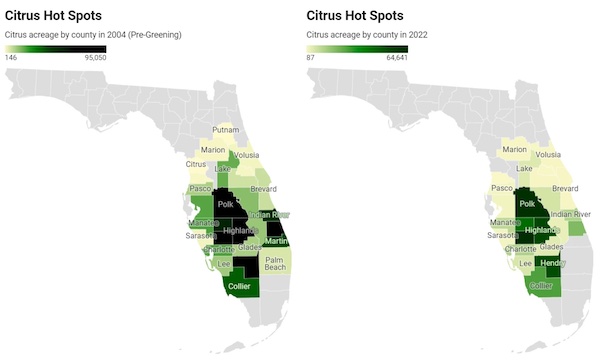Citrus greening disease has ravaged Florida’s citrus industry since it was first discovered there 25 years ago, with citrus production having since dropped nearly -80%. The devastating disease has also spread to citrus groves in California, Louisiana, and Texas, as well as over 30 other countries around the world. After over two decades of desperately seeking a cure, USDA researchers think they may have found a potential remedy that boosts the natural disease resistance of citrus trees.
Citrus greening, also called Huanglongbing (HLB) or yellow dragon disease, is spread by the Asian citrus psyllid (Diaphorina citri), which carries the Liberibacter bacteria that invades a tree’s vascular system. The disease eventually kills the tree, but before that HLB causes the fruit of infected trees to be green, bitter and deformed, making it undesirable to consumers and no longer valuable to the citrus grower.
HLB was first detected in southern China in 1919 where it is believed to have originated. The Asian citrus psyllid has been in Florida since at least 1998 but the disease wasn’t detected until 2005. It was detected in Louisiana in 2008, then Georgia and South Carolina in 2009. In 2012, citrus greening was confirmed in Texas and California. In the past decade in the US, HLB caused an approximately -21% decrease in the fresh citrus fruit market and about a -72% decline in the production of oranges used for juice and other products. In Florida alone, orange production has dropped -90%, from 150 million boxes in 2005 to just 16 million boxes expected in 2023.
Citrus growers have been spraying antibiotics to protect against the disease but the drugs have a hard time even reaching the bacteria as it lives deep inside the roots of the infected trees. Chemical pesticides can help control the insects that carry and spread the HLB bacteria but the insects eventually develop resistance. Another reason finding a remedy has been so elusive is the fact that the Liberibacter bacteria can’t be grown in a petri dish, so scientists don’t know that much about it. To date, the most effective solution has been to remove infected trees. Most infected trees die within a few years anyway.
According to James Thomson, a geneticist at USDA’s ARS Crop Improvement and Genetics Research (CIGR) unit in Albany, CA, by incorporating receptors that can recognize pathogens, they are able to activate a plant’s own innate immune responses. The scientists used what’s known as “agrobacteria,” a microbe that originated in soil, but has been turned into a plant engineering tool, according to Thomson. “Essentially you clone the DNA of interest [in this case, from plants that have a natural resistance the pathogen of concern] and add it to the agrobacteria, then the agrobacteria adds that specific bit of DNA to the genome.”
Getting the “loaded” DNA into targeted trees is the next step. “This is all done in the lab through tissue culture,” he said. “A bit of the original plant is cut into little pieces and mixed, temporarily, with the agrobacteria. The plant pieces are then cleaned of agrobacteria and encouraged to regrow into a whole plant.”
The researchers’ plan is to transfer their knowledge and technology to tree nurseries, where growers will be able to purchase the trees they need, when they need them. The result would have at least a three-fold economic benefit: growers will get disease-free trees to farm, nurseries will see increased profits, and consumers will have a larger (and potentially cheaper) supply of citrus products. “I see [this] HLB-fighting technology being deployed in the next several years,” Thomson said. (Sources: USDA, C&EN, American Farm Bureau, AgriBusiness Global)










